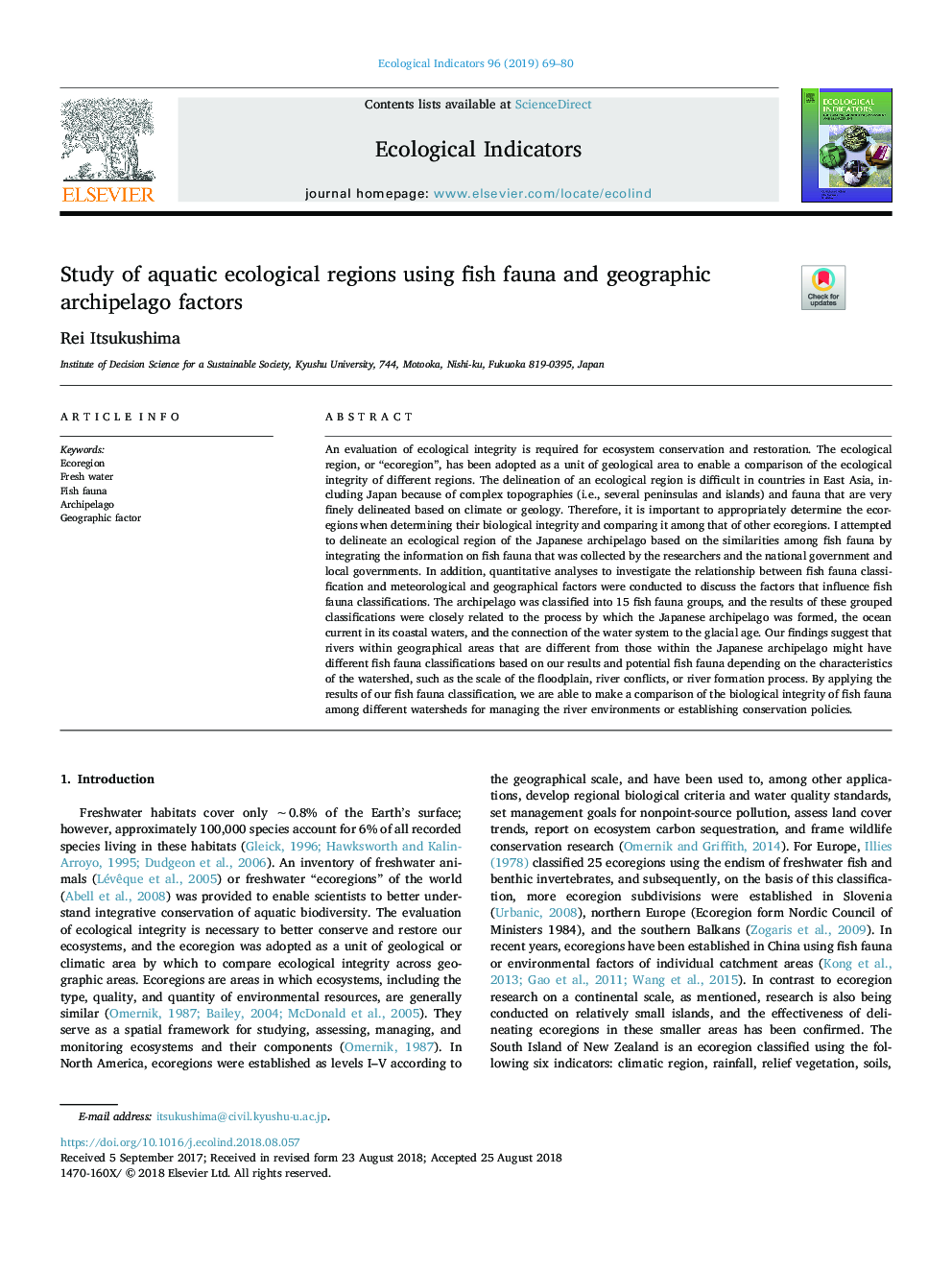| کد مقاله | کد نشریه | سال انتشار | مقاله انگلیسی | نسخه تمام متن |
|---|---|---|---|---|
| 10144189 | 1646298 | 2019 | 12 صفحه PDF | دانلود رایگان |
عنوان انگلیسی مقاله ISI
Study of aquatic ecological regions using fish fauna and geographic archipelago factors
ترجمه فارسی عنوان
بررسی مناطق اکولوژیکی آبزی با استفاده از فون ماهی و عوامل دریایی جغرافیایی
دانلود مقاله + سفارش ترجمه
دانلود مقاله ISI انگلیسی
رایگان برای ایرانیان
کلمات کلیدی
محیط زیست، آب تازه فون ماهی مجمع الجزایر، فاکتور جغرافیایی،
ترجمه چکیده
ارزیابی صحت زیست محیطی برای حفاظت و بازسازی اکوسیستم مورد نیاز است. منطقه اکولوژیک یا منطقه ای به عنوان یک واحد منطقه زمین شناسی به منظور مقایسۀ تمامیت زیست محیطی مناطق مختلف به تصویب رسیده است. تشریح یک منطقه اکولوژیک در کشورهای آسیای شرقی، از جمله ژاپن به دلیل توپوگرافی های پیچیده (به عنوان مثال، چندین جزیره و جزایر) و حیوانات بسیار دشوار است که براساس آب و هوا یا زمین شناسی مشخص است. بنابراین، هنگام تعیین تعادل بیولوژیکی و مقایسه آن با محیط زیست دیگر، مهم است که مناسب مناطق زیست محیطی را تعیین کنید. من تلاش کردم تا یک منطقه اکولوژیکی مجمع الجزایر ژاپن را بر اساس شباهت های فون ماهی با تلفیق اطلاعات مربوط به فون ماهی که توسط محققان و دولت ملی و دولت های محلی جمع آوری شده بود، مشخص کنم. علاوه بر این، تجزیه و تحلیل کمی برای بررسی رابطه بین طبقه بندی فون ماهی و عوامل هواشناسی و جغرافیایی برای بررسی عوامل موثر بر طبقه بندی فون ماهی انجام شد. مجمع الجزایر به 15 گروه فئون ماهی دسته بندی شد و نتایج این طبقه بندی های گروه بندی به شدت مربوط به فرایند تشکیل مجمع الجزایر ژاپن، جریان اقیانوس در آب های ساحلی و اتصال سیستم آب به دوره یخبندان بود . یافته های ما نشان می دهد که رودخانه ها در مناطق جغرافیایی متفاوت از آن در مجمع الجزایر ژاپن ممکن است دارای طبقه بندی های مختلف حیوانات ماهیانه بر اساس نتایج ما و حیوانات بالقوه ماهی بسته به ویژگی های حوزه آبریز، مانند مقیاس سیلاب، درگیری های رودخانه، یا فرآیند تشکیل رودخانه. با استفاده از نتایج طبقه بندی فون ماهی ما، ما می توانیم مقایسه یکپارچگی بیولوژیکی ماهی در میان حوزه های مختلف برای مدیریت محیط های رودخانه و یا ایجاد سیاست های حفاظت.
موضوعات مرتبط
علوم زیستی و بیوفناوری
علوم کشاورزی و بیولوژیک
بوم شناسی، تکامل، رفتار و سامانه شناسی
چکیده انگلیسی
An evaluation of ecological integrity is required for ecosystem conservation and restoration. The ecological region, or “ecoregion”, has been adopted as a unit of geological area to enable a comparison of the ecological integrity of different regions. The delineation of an ecological region is difficult in countries in East Asia, including Japan because of complex topographies (i.e., several peninsulas and islands) and fauna that are very finely delineated based on climate or geology. Therefore, it is important to appropriately determine the ecoregions when determining their biological integrity and comparing it among that of other ecoregions. I attempted to delineate an ecological region of the Japanese archipelago based on the similarities among fish fauna by integrating the information on fish fauna that was collected by the researchers and the national government and local governments. In addition, quantitative analyses to investigate the relationship between fish fauna classification and meteorological and geographical factors were conducted to discuss the factors that influence fish fauna classifications. The archipelago was classified into 15 fish fauna groups, and the results of these grouped classifications were closely related to the process by which the Japanese archipelago was formed, the ocean current in its coastal waters, and the connection of the water system to the glacial age. Our findings suggest that rivers within geographical areas that are different from those within the Japanese archipelago might have different fish fauna classifications based on our results and potential fish fauna depending on the characteristics of the watershed, such as the scale of the floodplain, river conflicts, or river formation process. By applying the results of our fish fauna classification, we are able to make a comparison of the biological integrity of fish fauna among different watersheds for managing the river environments or establishing conservation policies.
ناشر
Database: Elsevier - ScienceDirect (ساینس دایرکت)
Journal: Ecological Indicators - Volume 96, Part 1, January 2019, Pages 69-80
Journal: Ecological Indicators - Volume 96, Part 1, January 2019, Pages 69-80
نویسندگان
Rei Itsukushima,
